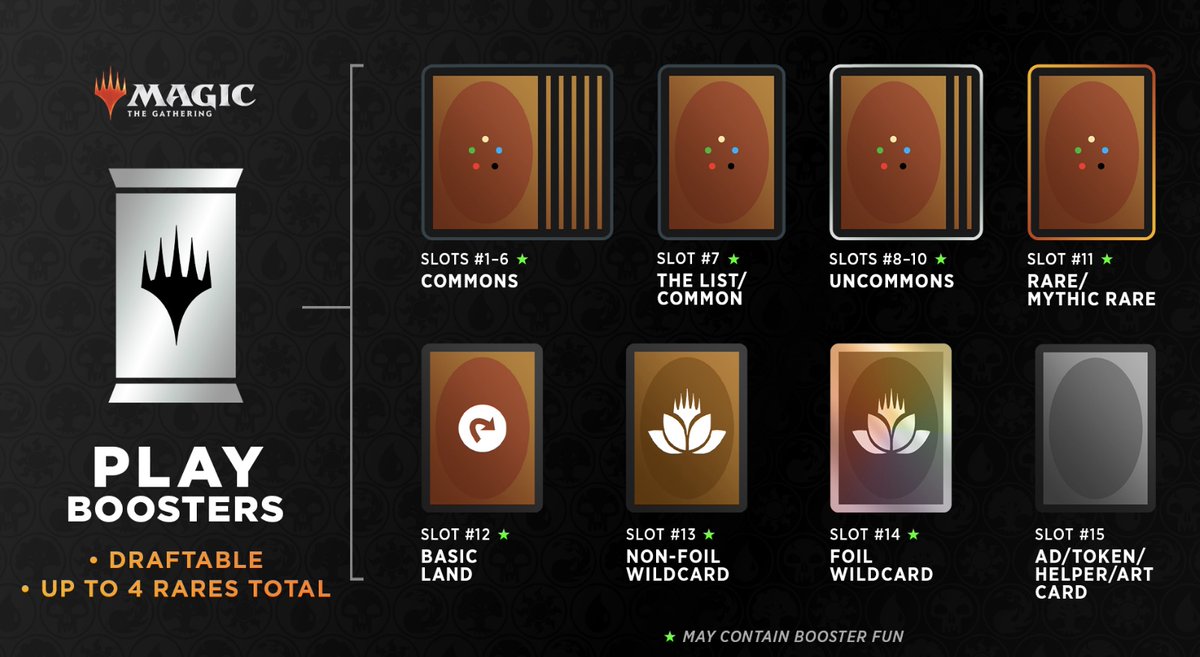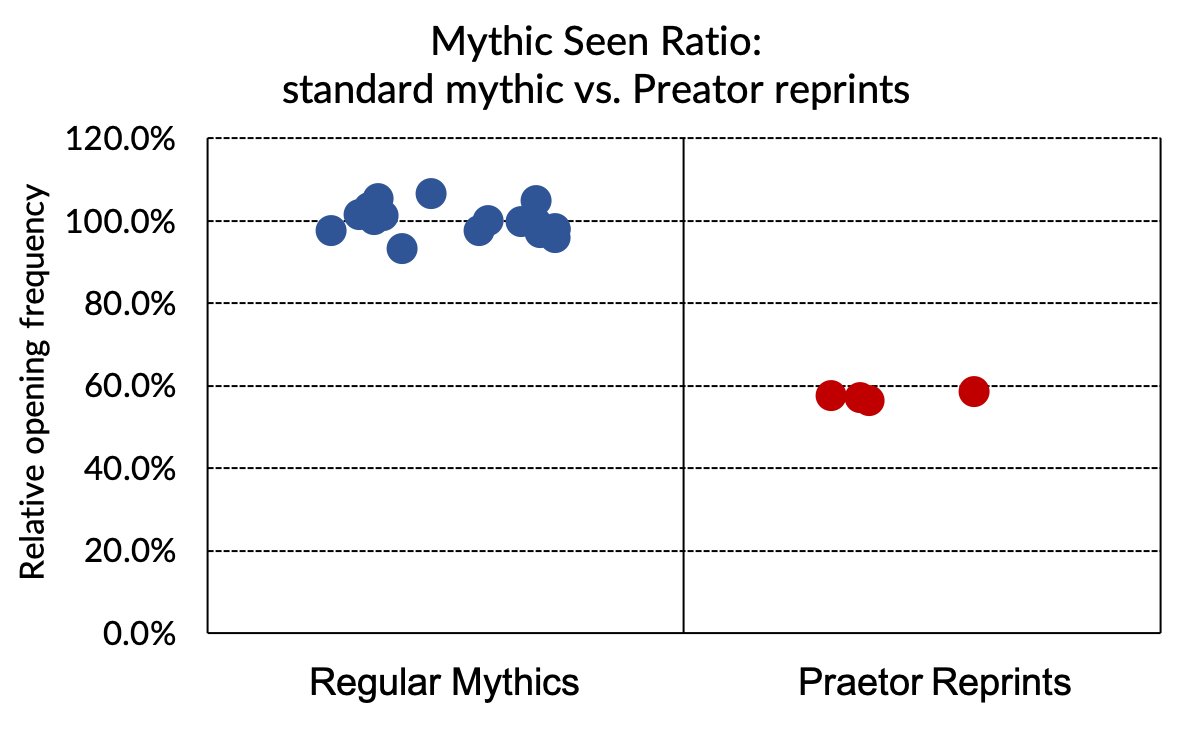
MtG data analysis. Host: Magic Numbers podcast; Collaborator: 17Lands, Mtgazone, LR. https://t.co/Q5pOl0WUCe; inquire for coaching via DMs; He/him
How to get URL link on X (Twitter) App


 Firstly, 7 sets going straight to Standard per year is a ton. Especially if 4 of the 7 are sold at premium price. People have to plan ahead which prereleases they can play and where the budget is too tight and that endangers communities in smaller places. FNMs don't fire,
Firstly, 7 sets going straight to Standard per year is a ton. Especially if 4 of the 7 are sold at premium price. People have to plan ahead which prereleases they can play and where the budget is too tight and that endangers communities in smaller places. FNMs don't fire, 
 How good is t1 Elf? Good. When played on T1 our expected winrate is around 66% on play and 63% on the draw. Decks with Llanowar that don't deploy it on T1, win only 54% on the play and 51% on draw. You're 14% more likely to cast T1 Elf on draw. Just maths of extra card draw. 2/9
How good is t1 Elf? Good. When played on T1 our expected winrate is around 66% on play and 63% on the draw. Decks with Llanowar that don't deploy it on T1, win only 54% on the play and 51% on draw. You're 14% more likely to cast T1 Elf on draw. Just maths of extra card draw. 2/9 



 School sort of works. There is a reason for that. You start with basically structured playing in reception, move through learning to read and write, count. You move to more and more complex ideas and finally graduate and forget all about what you learn over time. 2/19
School sort of works. There is a reason for that. You start with basically structured playing in reception, move through learning to read and write, count. You move to more and more complex ideas and finally graduate and forget all about what you learn over time. 2/19

 The "draft good cards" heuristic can be traced to @samuelhblack recount of strategy advice he got from a former Pro Mike Hron (Black, 2023), but different versions of this philosophy have been around for even longer. It just make sense. 2/21
The "draft good cards" heuristic can be traced to @samuelhblack recount of strategy advice he got from a former Pro Mike Hron (Black, 2023), but different versions of this philosophy have been around for even longer. It just make sense. 2/21 

 When it comes to color pair power level it seems we have 3 early tier one combinations: WU, WB and RB. There is a large chunk of color pairs that are lagging behind - remains to be seen which of those are just bad and which ones are just badly build in the early days. 2/8
When it comes to color pair power level it seems we have 3 early tier one combinations: WU, WB and RB. There is a large chunk of color pairs that are lagging behind - remains to be seen which of those are just bad and which ones are just badly build in the early days. 2/8 

 "But how do you get the Arena pick rate from non-17Lands users?" I estimate it. I know ALSA is non-linearly linked to pick rate and based on it, I can recalculate what the pick rate should be for given cards. Any outliers in the 17L user data can be then corrected for that. 2/12
"But how do you get the Arena pick rate from non-17Lands users?" I estimate it. I know ALSA is non-linearly linked to pick rate and based on it, I can recalculate what the pick rate should be for given cards. Any outliers in the 17L user data can be then corrected for that. 2/12

 First thing: the meta plan. Everyone figured out card draw is good. But this is only layer 1. Layer 2 is disruption. Counters and discard. Layer 3 is the inevitability. You want to build your deck so that after your turn oppo is locked. Hellbent against a counter or dead. 2/9
First thing: the meta plan. Everyone figured out card draw is good. But this is only layer 1. Layer 2 is disruption. Counters and discard. Layer 3 is the inevitability. You want to build your deck so that after your turn oppo is locked. Hellbent against a counter or dead. 2/9

 Notable flops were Greasefang and MonoG (not that @DanaFischerMTG cares - congrats). Also Rakdos Transmogrify and Jund Sac underperformed.
Notable flops were Greasefang and MonoG (not that @DanaFischerMTG cares - congrats). Also Rakdos Transmogrify and Jund Sac underperformed.
 Tagged along many spells in the format, MD lets you look at the top 2 cards of your library and put one of them face down. If it is a creature, you can turn it face up any time for its casting cost. That is neat. But is it broken? 2/11
Tagged along many spells in the format, MD lets you look at the top 2 cards of your library and put one of them face down. If it is a creature, you can turn it face up any time for its casting cost. That is neat. But is it broken? 2/11 

 It is late enough in the game to have loads of data, but not so late that I have to exclude too many games. And I excluded every game that ended t5 or earlier, so keep in mind - all the most lopsided games are not in this analysis, something to keep in mind. 2/21
It is late enough in the game to have loads of data, but not so late that I have to exclude too many games. And I excluded every game that ended t5 or earlier, so keep in mind - all the most lopsided games are not in this analysis, something to keep in mind. 2/21

 Firstly, despite the decks winning only 54% of the games, individual cards do well. 8 commons have a GiH WR >59%.
Firstly, despite the decks winning only 54% of the games, individual cards do well. 8 commons have a GiH WR >59%. 

 Firstly, WotC focused on the fact that you could potentially open up to 4 rares in a pack. Yes, theoretically it is true. But realistically - it probably is a once several boxes experience. To look at it, we need to see what would need to happen. 2/12
Firstly, WotC focused on the fact that you could potentially open up to 4 rares in a pack. Yes, theoretically it is true. But realistically - it probably is a once several boxes experience. To look at it, we need to see what would need to happen. 2/12

 First - let's rethink what a win rate is. In its simplified view it will frequently look like this: Titanic Growth has a good Game in Hand Win Rate in RG decks. It is the 4th best common in those decks so I guess it is just a good RG card. 2/19
First - let's rethink what a win rate is. In its simplified view it will frequently look like this: Titanic Growth has a good Game in Hand Win Rate in RG decks. It is the 4th best common in those decks so I guess it is just a good RG card. 2/19 

 Thanks to the infinite kindness of @17Lands team I got some early access data to try and figure out what is the impact of the pack collation on the card frequency. Firstly let's look at how packs look like in a regular set: Simple 1 rare/mythic, 3 uncommons and 10 commons. 2/11
Thanks to the infinite kindness of @17Lands team I got some early access data to try and figure out what is the impact of the pack collation on the card frequency. Firstly let's look at how packs look like in a regular set: Simple 1 rare/mythic, 3 uncommons and 10 commons. 2/11

 First difficulty is to find those builds. But over time I developed a toolbox to do it. And weirdly, I use methods from my day job to do so.
First difficulty is to find those builds. But over time I developed a toolbox to do it. And weirdly, I use methods from my day job to do so. 
 Yes, part of it is because some archetypes have an appalling win rate. But that is a problem in itself. Bottom 4 color pairs in this dataset are all from ONE. It would be easy to blame it on players who just didn't figure out the right builds, and in part it is probably true. 2/x
Yes, part of it is because some archetypes have an appalling win rate. But that is a problem in itself. Bottom 4 color pairs in this dataset are all from ONE. It would be easy to blame it on players who just didn't figure out the right builds, and in part it is probably true. 2/x

 @17Lands You need to look at the times a card has been seen in the Card performance data. Number times seen depends on number times open. But! Of course cards that go later will be seen even more. Just look at the difference between Staff of Compleation (2313) and Nissa (777) 2/x
@17Lands You need to look at the times a card has been seen in the Card performance data. Number times seen depends on number times open. But! Of course cards that go later will be seen even more. Just look at the difference between Staff of Compleation (2313) and Nissa (777) 2/x 


 I also look at every archetype and identify best performing and worst performing cards for each. To see the details of methodology - watch the stream, but I basically look at cards overrepresented in well performing decks. 9/x
I also look at every archetype and identify best performing and worst performing cards for each. To see the details of methodology - watch the stream, but I basically look at cards overrepresented in well performing decks. 9/x

 First of all, VOW is not a 10 archetype format - it is more like Ikoria, where enemy pairs were more supported and allied colours were not fully supported. Here it is vice versa, with allied pairs having better archetype support. Allied pairs are drafted more. 2/x
First of all, VOW is not a 10 archetype format - it is more like Ikoria, where enemy pairs were more supported and allied colours were not fully supported. Here it is vice versa, with allied pairs having better archetype support. Allied pairs are drafted more. 2/x 